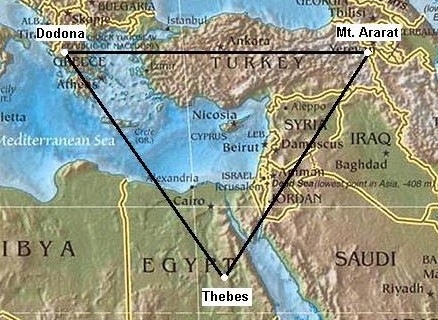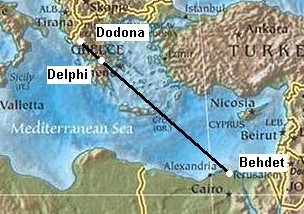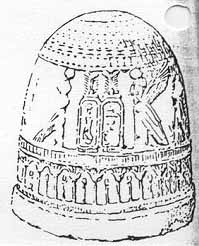|
Location:
Epirus, Greece. |
Grid Reference:
39� 32' 47" N, 20� 47' 16" E |
 Dodona:
(Oracle Centre).
Dodona:
(Oracle Centre).
The
oldest Greek oracle and location of the landing place of the ark in
Greek mythology.
Dodona was the oldest Hellenic oracle centre according to the
fifth-century historian Herodotus. Aristotle considered the region to
have been the most ancient part of Greece and where the Hellenes
originated.
(4)
Priestesses and priests in the sacred grove interpreted the rustling of
the oak (or beech) leaves to determine the correct actions to be taken.
Archaeological excavations
have recovered artefacts from as early as the Mycenaean era
(3),
and prehistoric sites at Dodona, have been shown to have been in
existence since about 2,000 BC.
(6)
Originally a shrine to
the mother goddess Gaia or Dione, Dodona came to be shared by Zeus
who's consort became Dione. There were no permanent structures when Homer
wrote the Iliad around 750 BC, at Dodona until the 4th century BC.
|
Herodotus accounts
of the origin of Dodona.
Herodotus records
two different accounts for the origin of Dodona. He wrote firstly
that he was told by priests at Egyptian Thebes (Karnak)
that "two priestesses had been carried away from Thebes by
Phoenicians; one, they said they had heard was taken away and sold
in Libya, the other in Hellas; these women, they said, were the
first founders of places of divination in the aforesaid countries."
This story suggests that the oracles at the oasis of Siwa in Libya
and of Dodona in Epirus were equally old, but similarly transmitted
from Egypt by Phonecians, and that the priestesses were women.
Herodotus also
recorded what he was told by the prophetesses, called peleiades
("doves") at Dodona which was
that 'two black doves had come flying from Thebes in Egypt, one to
Libya and one to Dodona; the latter settled on an oak tree, and
there uttered human speech, declaring that a place of divination
from Zeus must be made there; the people of Dodona understood that
the message was divine, and therefore established the oracular
shrine. The dove which came to Libya told the Libyans (they say) to
make an oracle of Ammon; this also is sacred to Zeus. Such was the
story told by the Dodonaean priestesses, the eldest of whom was
Promeneia and the next Timarete and the youngest Nicandra; and the
rest of the servants of the temple at Dodona similarly held it
true'.
Ref: Herodotus (Histories 2:54�57)
|
According to Herodotus, the oracle was a
woman who interpreted the rustling of the wind in the oak trees as well as
the sounds of copper vessels being struck. Like the Pythia at Delphi, the
oracle was fabled to enter a trance-like frenzy while delivering her
responses to questions written on lead tablets.
|
Dodona and the Oracle
Octave: Geodetic Placement.
Having mentioned that Herodotus associated the
origin of Dodona with Thebes in Egypt (above), it is of interest
that both sites have been proposed to have been located according to
an apparently deliberate geodetic placement of sacred temples
and shrines.
Dodona is the Mythological landing place for
Deucalion after the flood, while Ararat is known in Hebraic as the
landing place of the Ark for Noah. Apart from this early
mythological connection between sites, there is a geographical
similarity in that both have ancient oracle centres to the
earth-mother placed next to dominant mountains and the distance
between them is the same as the distance between Dodona and Thebes,
so that the three sites form an almost exact equilateral triangle .

In the Case of Dodona which lies
at
39� 32' 47" N, 20� 47' 16" E, it was
suggested by Stecchini ( ), that its location was in accordance to a
larger system of deliberate geodetic placement of oracle sites.
including Delphi, Dodona and Delos, and other important sites in
both Greece and the Middle-east.
|
'Stecchini maintains
that the iconographically consistent presence of pairs of
pigeons, perched on, or on either side of, the omphaloi
, or "navels," of the ancient world, are an indication of
their function as the measurers of the geodetic absolute
center.
He adds, that, "from prehistoric times"
...
"carrier pigeons [were] used for establishing geographic
distances.
According to
Greek legends, a central geodetic point was obtained by
loosing two birds of equal strength and using the mean of
the time employed in flight. This would allow for
differences in wind current and other variables. By repeated
flights even more accurate measurements could be obtained.
In ancient literature and iconography the flight of two
doves is the standard symbol for the stretching of meridians
and parallels.
With Stecchini's
information in hand, it becomes possible to see that the
dove-stories originating out of Egypt are a direct reference
to the mathematical calculations used by the Egyptian priests
to establish that their place in the world was at the absolute
center'.
(2) |
Herodotus noted the religious transference from the earlier
earth-mother-goddess to a pantheon of gods between Greece and Egypt,
at the same time confirming the status of Dodona as the first Greek
oracle site, and places the existence of oracles before the gods.
He said:
�After a long lapse of time the names of the gods came to Greece
from Egypt� not long after the arrival of the names, they sent to
consult the oracle at Dodona about them. This is the most ancient
oracle in Greece, and at that time there was no other.�
(24)
In addition to
having been recorded as the first Greek oracle centre, Dodona has a
still greater, and older claim to fame being located at the foot of
Mount Tomaros, which is named in Greek myth as the refuge for
Deucalion and his wife, the sole survivors of the great �flood of
Deucalion�. It is within this myth that an older, perhaps hidden
significance (and connection), can be found in the location of
Dodona, for while Mt. Tomaros is the reputed resting place of the
Greek ark, the Hebrews record the final resting place of their ark
as being on Mount Ararat in Turkey (near Metsamor), which both sits
on the same latitude as Dodona and happens to be equidistant from
Thebes, so that the three locations form an almost perfect
equilateral triangle. It is also interesting to note the location of
the 30th parallel in connection to this triangle, as it
runs across it a third of the way its height. (See Appendix B for
further details).
Having already
seen that certain prominent sacred sites from Northern (Lower) Egypt
share a geometric and geodetic connection with the region of Mount
Ararat, we can see now that Thebes, the geodetic centre of Southern
(Upper) Egypt, also shares a similar relationship. The accuracy
between the locations of these three important sites lends favour to
Stecchini�s suggestion of a deliberate placement of ancient oracle
centres. It is also apparent that as well as having a geometric
relationship, a geodetic one can be seen at both Egyptian sites
(namely, Heliopolis being on the 30th parallel in the
North, and Thebes being located exactly 2/7th�s of the
distance from the Equator to the North pole).
While it is
possible that such a geometric connection between sites may be a
coincidence, the earlier mythological connections (of earth-mother
and ark) are harder to explain. It is not possible to know if the
significance of the site was already known to the Egyptian priests
at Thebes (or Phoenicians) when the oracle at Dodona was
established, but there is little doubt that the location had a
special significance from before the arrival of the Egyptian
oracles.
A s
if to confirm that the placement of sacred sites was ordained
through geodetic principles, a look at the most famous of all Greek
oracle centres brings us to the one at Delphi which contains a
tradition of geodesy in its origin myth, which says that it was
located by Zeus who released two birds from the eastern and western
ends of the earth, with the point where they flew past each other
being considered the centre of the world and therefore marked with
an omphalus stone. As well as being located almost exactly one
degree south of Dodona, it also happens to be placed 3/7th�s
of the distance from the equator to the North Pole. Delphi also lies
along the same alignment formed by connecting Dodona to Behdet in
Egypt (which was the geodetic capital of Northern Egypt before 3,000
BC according to Stecchini), and which sits on the same longitude as
Thebes and the same Latitude as Alexandria. It is noticeable that as
well as forming an alignment, these three oracle sites are separated
by almost exact degrees of latitude (based on a division of 360�). s
if to confirm that the placement of sacred sites was ordained
through geodetic principles, a look at the most famous of all Greek
oracle centres brings us to the one at Delphi which contains a
tradition of geodesy in its origin myth, which says that it was
located by Zeus who released two birds from the eastern and western
ends of the earth, with the point where they flew past each other
being considered the centre of the world and therefore marked with
an omphalus stone. As well as being located almost exactly one
degree south of Dodona, it also happens to be placed 3/7th�s
of the distance from the equator to the North Pole. Delphi also lies
along the same alignment formed by connecting Dodona to Behdet in
Egypt (which was the geodetic capital of Northern Egypt before 3,000
BC according to Stecchini), and which sits on the same longitude as
Thebes and the same Latitude as Alexandria. It is noticeable that as
well as forming an alignment, these three oracle sites are separated
by almost exact degrees of latitude (based on a division of 360�).
Dodona (39�
30' N. 20� 51' E)
Delphi (38�
29' N, 22� 26' E)
Behdet (31�
30' N, 31� 14' E)
The oracle
centre at Delos also had an omphlus (with a serpent wrapped round
it), and we can see that it too was located almost exactly one
degree south of Delphi.
Delos � (37�
26� N,
25� 17� E)
It is sufficient for present to demonstrate the strength of
the connection between the regions of Mt. Ararat and that of Dodona,
both sharing the same mythological �fingerprint�, both on the same
latitude, and both equally distanced from Thebes, the ancient navel
of Egypt. However, it is clear from Santillana�s work that there is
evidence of a complex set of traditions involving the following
themes: Navel-stones, Geometry and Astronomy and a flood event.
  
Omphalos stones from Left to Right:
Delphi, Delos, Karnak.
We have
already seen that the two sites for the landing of the ark are
geometrically connected; this reference to the ark leads us neatly
to the aspect of navel stones, which were famously found at both
Thebes in Egypt and at Delphi (two). In order to understand the
significance of the oracle centres it has been necessary to look at
the myths that surround them, this proves to be the case with the
Omphalii too.
(More
about Omphalos and Earth Navels) (Other
Prehistoric Geometric alignments) |
Plugging The Deep.
Having already determined the existence of an ancient geometric
relationship between Dodona and Mt. Ararat (Metsamor), it is
interesting to find that Stecchini
(1), offers several examples to
support the association between navel-stones and �the flood� by
referring to their function as �plugs�; an idea typified by the
following phrase �The opening of the navel brings the deluge�.
However of even greater interest is that we see in �Hamlet�s Mill�
(5),
that certain common subject matter has been approached but through a
different medium, namely mythology. The primary emphasis of their
research was the existence of an ancient system of astronomical/
astrological knowledge involving the precession of the equinoxes,
and the constellations, stored in mythologies around the world. It
is from their work we are made aware of a significant set of stories
concerning the purpose of navel-stones, through which such already
described associations are reinforced.
In
the Sumerian myth of Utnapishtim (Noah), we are told that the first
ark was �a cube measuring 60x60x60 fathoms�,
which represents the unit in sexagesimal system (where 60 is written
as 1 or 1� ). In one version, we are told that �there is no ark,
just a cubic stone, which rests on a pillar which reaches from earth
to heaven�. In the Old Testament, these elements are repeated,
when we learn that Noah�s ark was also a cube, whose landing
symbolised the end of the great flood. In Jewish legends, it is said
that �since the ark disappeared there was a stone in its
place�which was called the foundation stone��and it is said to lie
above the waters that are below the Holy of Holies. In Mecca, the
navel of the Islam faith, there stands the Holy stone of the Ka�aba,
which is also a cube, and we are told that even Christ is compared to
�a cube shaped mountain�. But why a cube?
Apart
from the obvious fact that a cube represents a single unit (as in the
Sumerian base-6), the traditional reason for the cube-shape is
suggested as being the shape designated for the planet Saturn, as
illustrated in Keplers �Mysterium Comographicum�. To support
this idea Santillana reminds us that in this group of stories, the
figure (power) who warns �Noah� of the impending flood, (and suggests
the dimensions of the Ark), is ��Saturn, as Jehovah, as Enki, as
Tane, etc��. The antiquity of these traditions is shown by the
fact that In pre-Islamic days, before the Ka�aba was constructed,
there was a well on the site, which had a statue of the �God�� Hubal,
across the opening �to prevent the waters from rising�.
Hildegard Levy points out that, in pre-Islamic days, the god Hubal was
Saturn, and that the Holy stone of the Ka�aba served the same symbolic
function
(5).
Having touched upon the idea that the traditions and symbolism of the
Greek Oracle centres have several stark similarities to earlier pagan
deities, it is also possible to see that the comparatively unknown
�Eleusian mysteries� are also associated with the exact same deities
(or versions of them). In fact, these similarities are so strong that
it is difficult to ignore the possibility that they are both part of
the same belief system. In addition, we are offered support for the
idea of a relationship between the placement of ancient Greek
locations, the application of longitude/latitude and the Eleusian
mysteries from a Frenchman called Xavier Guichard.
(More about
the Eleusian Mysteries)
|
|


 s
if to confirm that the placement of sacred sites was ordained
through geodetic principles, a look at the most famous of all Greek
oracle centres brings us to the one at Delphi which contains a
tradition of geodesy in its origin myth, which says that it was
located by Zeus who released two birds from the eastern and western
ends of the earth, with the point where they flew past each other
being considered the centre of the world and therefore marked with
an omphalus stone. As well as being located almost exactly one
degree south of Dodona, it also happens to be placed 3/7th�s
of the distance from the equator to the North Pole. Delphi also lies
along the same alignment formed by connecting Dodona to Behdet in
Egypt (which was the geodetic capital of Northern Egypt before 3,000
BC according to Stecchini), and which sits on the same longitude as
Thebes and the same Latitude as Alexandria. It is noticeable that as
well as forming an alignment, these three oracle sites are separated
by almost exact degrees of latitude (based on a division of 360�).
s
if to confirm that the placement of sacred sites was ordained
through geodetic principles, a look at the most famous of all Greek
oracle centres brings us to the one at Delphi which contains a
tradition of geodesy in its origin myth, which says that it was
located by Zeus who released two birds from the eastern and western
ends of the earth, with the point where they flew past each other
being considered the centre of the world and therefore marked with
an omphalus stone. As well as being located almost exactly one
degree south of Dodona, it also happens to be placed 3/7th�s
of the distance from the equator to the North Pole. Delphi also lies
along the same alignment formed by connecting Dodona to Behdet in
Egypt (which was the geodetic capital of Northern Egypt before 3,000
BC according to Stecchini), and which sits on the same longitude as
Thebes and the same Latitude as Alexandria. It is noticeable that as
well as forming an alignment, these three oracle sites are separated
by almost exact degrees of latitude (based on a division of 360�).


